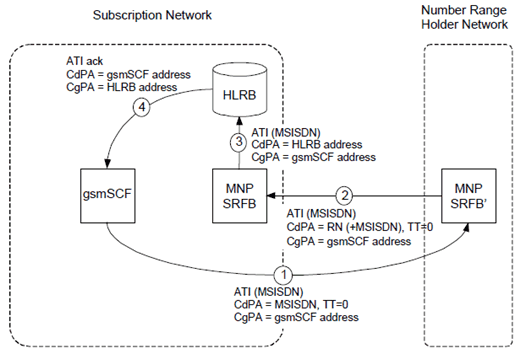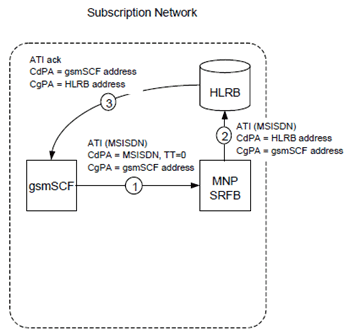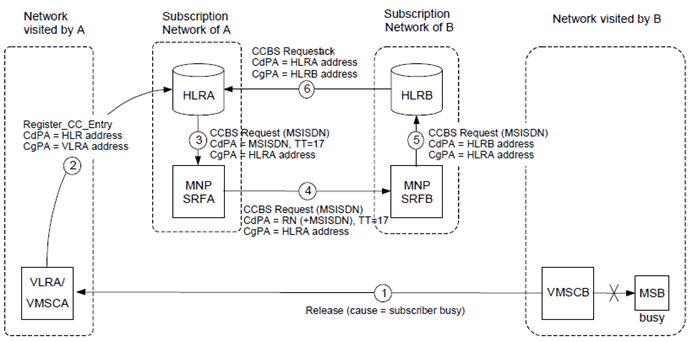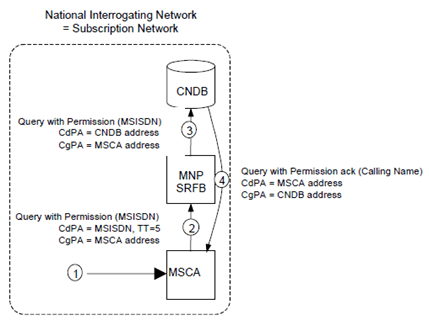Content for TS 23.066 Word version: 18.0.0
B.4.7 Any Time Interrogation for a Ported Number - Indirect Routeing
B.4.8 Any Time Interrogation for a Ported Number - Direct Routeing
B.4.9 CCBS where the Busy Subscriber is a Ported Subscriber Direct Routeing
B.4.10 Calling Name Presentation Flows - MNP-SRF acts as SCCP Relay
...
...
B.4.7 Any Time Interrogation for a Ported Number - Indirect Routeing p. 55
Figure B.4.7 shows the MNP-SRF operation for routeing an Any_Time_Interrogation message for a ported number where the interrogating network does not support direct routeing.
The message flows for this scenario are based on the use of an SCCP-relay function in the MNP-SRFs. If the MNP-SRFs use a higher-level relay function (e.g. TC-relay), then the response message will go via the MNP-SRF as shown in clause B.4.2. For further details of the signalling relay functions, the reader is referred to [7].

Figure B.4.7: MNP-SRF operation for routeing an Any_Time_Interrogation message for a ported number where the interrogating network does not support direct routeing
(⇒ copy of original 3GPP image)
(⇒ copy of original 3GPP image)
- The gsmSCF generates an Any_Time_Interrogation (ATI) message. The message is routed to the number range holder network's MNP-SRF.
- When MNP-SRFB' receives the message, MNP-SRF operation is triggered. The MNP-SRF functionality analyses the MSISDN in the CdPA and identifies the MSISDN as being ported using information which may be retrieved from an NP database. As the message is non-call related, the MNP-SRF function then populates the CdPA with either a routeing number or a concatenation of a routeing number and MSISDN. After modifying the CdPA, the message is routed to MNP-SRFB in the subscription network.
- When MNP-SRFB receives the message, MNP-SRF operation is triggered. The MNP-SRF functionality analyses the MSISDN in the CdPA and identifies the MSISDN as being ported into the network using information which may be retrieved from an NP database. The MNP-SRF function then populates the CdPA with an HLRB address. After modifying the CdPA, the message is routed to HLRB.
- HLRB responds to the ATI by sending back an ATI ack with the requested information.
B.4.8 Any Time Interrogation for a Ported Number - Direct Routeing p. 56
Figure B.4.8 shows the MNP-SRF operation for routeing an Any_Time_Interrogation message for a ported number where the interrogating network supports direct routeing.
The message flows for this scenario are based on the use of an SCCP-relay function in the MNP-SRF. If the MNP-SRF uses a higher-level relay function (e.g. TC-relay), then the response message will go via the MNP-SRF as shown in clause B.4.2. For further details of the signalling relay functions, the reader is referred to [7].

Figure B.4.8: MNP-SRF operation for routeing an Any_Time_Interrogation message for a ported number where the interrogating network supports direct routeing
(⇒ copy of original 3GPP image)
(⇒ copy of original 3GPP image)
- The gsmSCF generates an Any_Time_Interrogation (ATI) message. The message is routed to the network's MNP-SRF.
- When MNP-SRFB receives the message, MNP-SRF operation is triggered. The MNP-SRF functionality analyses the MSISDN in the CdPA and identifies the MSISDN as being ported into the network using information which may be retrieved from an NP database. The MNP-SRF function then populates the CdPA with an HLRB address. After modifying the CdPA, the message is routed to HLRB.
- HLRB responds to the ATI by sending back an ATI ack with the requested information.
B.4.9 CCBS where the Busy Subscriber is a Ported Subscriber Direct Routeing p. 57
Figure B.4.9 shows the MNP-SRF operation for routeing a CCBS Request for a ported number where the interrogating network supports direct routeing.
The message flows for this scenario are based on the use of an SCCP-relay function in the MNP-SRFs. If the MNP-SRFs use a higher-level relay function (e.g. TC-relay), then the response message will go via the MNP-SRF as shown in clause B.4.2. For further details of the signalling relay functions, the reader is referred to [7].

Figure B.4.9: MNP-SRF operation for routeing a CCBS Request for a ported number where the interrogating network supports direct routeing
(⇒ copy of original 3GPP image)
(⇒ copy of original 3GPP image)
- The VMSCA receives a ISUP Release message with cause value 'subscriber busy' from VMSCB.
- VLRA/VMSCA sends a Register_CC_Entry to HLRA using the HLRA address as CdPA on SCCP.
- The HLRA sends a CCBS Request message to the networks MNP-SRFA.
- When MNP-SRFA receives the message, MNP-SRF operation is triggered. The MNP-SRF functionality analyses the MSISDN in the CdPA and identifies the MSISDN as being ported using information which may be retrieved from an NP database. As the message is non-call related, the MNP-SRF function then populates the CdPA with either a routeing number or a concatenation of a routeing number and MSISDN. After modifying the CdPA, the message is routed to MNP-SRFB in the subscription network.
- When MNP-SRFB receives the message, MNP-SRF operation is triggered. The MNP-SRF functionality analyses the MSISDN in the CdPA and identifies the MSISDN as being ported into the network using information which may be retrieved from an NP database. The MNP-SRF function then populates the CdPA with an HLRB address. After modifying the CdPA, the message is routed to HLRB.
- HLRB can now respond to HLRA by sending back a CCBS ack message.
B.4.10 Calling Name Presentation Flows - MNP-SRF acts as SCCP Relay p. 58
Figure B.4.10 shows the MNP-SRF operation for delivering an CNAP message to an ANSI Calling Name Database.

Figure B.4.10: SRF operation for delivering an CNAP message to the CNDB
(⇒ copy of original 3GPP image)
(⇒ copy of original 3GPP image)
- An incoming call: an Initial Address message with Generic Name parameter set to "presentation allowed" is received at a MSC. The MSC inteerogates the VLR to determine if the called party is subscribed to the CNAP service. The VLR Response indicates that the called party is subscribed to CNAP;
- The MSC generates a TCAP message "Query With Permission". The Query With Permission message is routed to the network's MNP-SRF;
- When MNP-SRFB receives the message, MNP-SRF operation is triggered. The MNP-SRF functionality analyses the MSISDN in the CdPA and identifies which CNDB the MSISDN is populated using information which may be retrieved from an NP database. The MNP-SRF function then populates the CdPA with an CNDB address. After modifying the CdPA, the message is routed to CNDB;
- CNDB responds to the routeing enquiry by sending back a Query With Permission ack with the address of the MSC. The MSC can now deliver the Calling Name to the terminating subscriber.